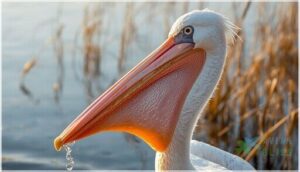This site is supported by our readers. We may earn a commission, at no cost to you, if you purchase through links.
Spotting an American white pelican gliding over a Tennessee lake feels a bit like seeing a cloud take flight—wings stretching nearly ten feet, casting a shadow that dwarfs most other birds. These pelicans rank among North America’s largest, and their striking white feathers, tipped with black, make them easy to recognize even from a distance.
You’ll often find them gathered in groups, working together to corral fish with a precision that rivals any fisherman’s net. Understanding where they live, what they eat, and how they raise their young reveals just how adapted these birds are to the shifting landscapes around them.
Table Of Contents
- Key Takeaways
- American White Pelican Physical Characteristics
- Habitat and Geographic Distribution
- Diet and Foraging Behavior
- Breeding, Nesting, and Life Cycle
- Conservation Status and Key Threats
- Frequently Asked Questions (FAQs)
- What is the difference between an American White Pelican and a Brown Pelican?
- What does the american white pelican eat?
- What are some of the threats to the American white pelican population?
- What is the population of American white pelicans?
- Where do American white pelicans live?
- Are American white pelicans rare?
- What is the difference between male and female American white pelican?
- What is a fun fact about the American white pelican?
- How do American White Pelicans protect themselves from predators?
- Can American White Pelicans be found in urban areas?
- Conclusion
Key Takeaways
- American white pelicans are among North America’s largest birds, easily recognized by their ten-foot wingspan and striking white-and-black plumage.
- These pelicans thrive in colonies on isolated islands and wetlands, migrating seasonally between northern breeding grounds and southern coastal wintering sites.
- Their feeding strategy relies on teamwork, using coordinated surface foraging to scoop up fish, crayfish, and salamanders rather than plunge-diving.
- Conservation status is currently stable, but habitat loss, climate change, and human disturbance remain ongoing threats to their populations.
American White Pelican Physical Characteristics
When you spot an American White Pelican gliding overhead, you’re looking at one of the most impressive birds on the continent.
These giants stand out not just for their size, but for a collection of features that seem almost prehistoric. Let’s walk through what makes their appearance so striking and easy to identify.
Size, Wingspan, and Majestic Appearance
You’ll be struck by the American White Pelican’s sheer size—one of North America’s largest birds. Males generally weigh between 6.34 and 13.6 kg, while females average a lighter 4.97 kg, showing clear sexual dimorphism. The wingspan stretches from 2.4 to 3.0 m, second only to the California condor.
In flight, these pelicans soar to altitudes of 4,240 m, their broad wings creating an unforgettable visual impact. They can often be found in shallow bodies of water throughout Tennessee.
Distinctive White-and-Black Plumage
You’ll notice the American White Pelican’s striking white body contrasts sharply with black primaries and outer secondaries along the wing edges. This distinctive pattern creates a bold black-and-white wingspan stretching 2.4 to 2.9 meters. Juveniles wear gray-brown plumage for roughly three years before developing adult coloring.
During breeding season, adults develop a yellowish breast wash, enhancing their overall appearance. They’re classified in the Pelicaniformes order, which includes pelicans and related birds.
Large Bill and Unique Pouch
Alongside its bold plumage, the American White Pelican’s enormous orange bill and stretchy pouch stand out. This bill measures up to 47 cm, dominating the bird’s head profile.
The pouch can hold several gallons of water, supporting feeding behavior by scooping fish. It also helps with thermoregulation and display communication, making these features essential for survival and social interaction.
Breeding Season Color Changes
During the breeding season, the American White Pelican’s bill and pouch shift from pale to vivid orange, with a unique Nuptial Tubercle forming on the upper bill. Plumage ornamentation intensifies, including a yellowish crest, all driven by hormone influence.
These color signaling changes support mate attraction within colonies, highlighting the bird’s readiness for breeding and reflecting typical pelican behavior and diet cycles.
Habitat and Geographic Distribution
Where you find American White Pelicans depends a lot on the season and the landscape. These birds have some favorite places for nesting, feeding, and spending the winter.
Let’s look at the habitats and regions they choose across North America.
Preferred Habitats: Lakes, Wetlands, and Coasts
Picture a pelican gliding over a mosaic of Lake Nesting Islands, Wetland Foraging Zones, and Coastal Winter Havens—each habitat is a lifeline.
You’ll find American White Pelicans in inland lakes, sprawling wetlands, and sheltered coastal environments.
Habitat Connectivity is essential; pelican habitat stretches from riverine stopovers to open marshes, weaving together safe nesting and rich feeding areas.
Breeding and Wintering Grounds
Every summer, American White Pelicans gather in northern breeding colonies—places like Marsh Lake in Minnesota or Chase Lake in North Dakota. These nesting grounds are chosen for safety and food.
When fall arrives, flocks migrate south to wintering sites along the Pacific and Gulf coasts, favoring sheltered bays. Habitat selection drives their nesting behavior and connects summer breeding to winter range.
Migration Patterns and Range Map
When spring arrives, you’ll notice American White Pelicans moving in large, V-shaped flocks, riding thermals along major Flyway Corridors. Their migration patterns shift with the seasons, connecting northern breeding grounds to southern wintering areas.
Regional phenology varies, but you can track their geographical distribution on range maps that highlight:
- Seasonal Ranges and migration timing
- Preferred wintering grounds
- Daytime Flight Behavior
Notable Locations in North America
You’ll find some of North America’s largest American White Pelican breeding colonies at Chase Lake in North Dakota and Marsh Lake in Minnesota, where thousands gather each summer.
During migration, flocks follow routes through the Great Plains, stopping at freshwater sanctuaries along the way.
In winter, look for them at coastal refuges on the Gulf Coast, California’s Central Valley, the Salton Sea, and along the Colorado River.
Diet and Foraging Behavior
American White Pelicans have a straightforward diet focused mainly on fish, though they’ll also eat crayfish and salamanders when the opportunity arises. Unlike their coastal cousins, these birds don’t plunge-dive for their meals—instead, they’ve developed some clever surface-feeding strategies.
Let’s look at how they find food, work together to catch it, and adapt their feeding habits throughout the day and night.
Primary Food Sources: Fish and Aquatic Life
You’ll find that American White Pelicans rely heavily on fish as their primary food source, consuming approximately 3 to 4 pounds daily. Their aquatic diet includes minnows, carp, suckers, and smaller schooling fish.
Pelicans show opportunistic feeding habits, adapting prey selection based on seasonal availability. During certain periods, salamanders, tadpoles, and crayfish supplement their diet, especially in wetland habitats where these aquatic prey are abundant.
Cooperative Feeding Techniques
Ever watched a flock of pelicans weave through water like a well-rehearsed team? American White Pelicans use synchronized swimming and group communication to herd fish into tight spots, boosting strike efficiency.
By forming lines or circles, their feeding behavior lets them catch more prey than solo foraging, impacting local fish populations and shaping the diet of the entire flock.
Surface Foraging Vs. Plunge Diving
You might notice how American White Pelicans favor surface foraging—scooping fish with their massive bills—over the dramatic plunge diving you see in Brown Pelicans. This feeding behavior means less energy expenditure and fits their morphological adaptations.
Habitat influence plays a role, too; shallow lakes let them select prey efficiently. Cooperative benefits boost success, shaping feeding habits and even bird migration patterns.
Nighttime and Daytime Feeding Habits
That surface foraging style carries into their feeding habits, but there’s a twist. During the breeding season, American White Pelican flocks grow larger at night, boosting Bill Dipping Rates in shallow lakes.
Nighttime brings bigger Nocturnal Prey Size—more fish and crayfish—while daytime sees smaller Diurnal Flock Size and faster Foraging Efficiency. It’s a practical shift to feed hungry chicks.
Breeding, Nesting, and Life Cycle
American White Pelicans are highly social birds, and you’ll almost never find one nesting alone. They gather in large breeding colonies during summer months, building simple nests on the ground where they raise their young through a fascinating developmental process.
From egg-laying to the moment chicks take their first flight, each stage reveals something striking about how these birds care for their offspring.
Colony Nesting and Social Structure
American white pelicans gather in impressive flocks at breeding locations on remote islands, forming colonies that can reach several thousand pairs. Their social breeding behavior creates tight-knit communities where you’ll observe:
- Synchronized courtship displays including circling flights and bowing at nesting sites
- Sub-colonies forming within larger groups as neighbors attract more breeding pairs
- Chick crèches developing when young pelicans leave nests at 2-3 weeks old
This colonial lifestyle shapes pelican behavior and affects both cooperative feeding strategies and colony vulnerabilities to disease.
Nest Construction and Egg Incubation
After those lively colony gatherings, you’ll notice the breeding habits of pelicans shift toward Nest Site Selection. Pairs choose flat ground on islands, crafting shallow depressions with their bills.
Nest Material Usage is practical—sand, shells, and weeds from nearby.
Egg Laying Patterns follow quickly, with two chalky eggs incubated by both parents using their webbed feet, a unique avian species behavior.
Chick Development and Parental Care
During the breeding season, you’ll see pelican parents invest heavily in chick feeding, working together to supply up to 150 pounds of fish for each young bird. Early growth metrics show rapid changes—chicks crawl, walk, and swim within weeks.
Key factors shaping survival include:
- Frequent feeding habits of pelicans
- Thermal regulation abilities
- Mortality causes like weather and starvation
Fledging and Juvenile Growth Stages
You’ll notice young pelicans first take flight around 9–10 weeks after hatching, weighing roughly 5,890 grams at fledging. Growth metrics show culmen length reaching 235 millimeters during this timeline.
Post-fledging care continues for three weeks as parents still provide food. Plumage development shows mottled gray-and-white feathers, and survival rates average 59 percent through the first year despite habitat and conservation status challenges.
Conservation Status and Key Threats
The American White Pelican’s story isn’t all smooth sailing, though the news is better than it once was. After a rough stretch through the mid-1900s, populations have rebounded considerably since the 1970s, earning them a “Least Concern” status today.
Still, these impressive birds face real challenges that you should know about if you want to understand their future.
Population Trends and Current Numbers
Ever wonder how the story of Pelecanus erythrorhynchus unfolds across North America? Breeding Pair Estimates show around 180,000 adults, with Colony Size Variation from Idaho’s 4,000 to Minnesota’s 22,000 pairs.
Regional Population Shifts reveal steady growth since the 1970s. Historical Data Comparison highlights doubled nest counts.
Monitoring Program Success helps track Conservation Status and prevent population decline.
Habitat Loss and Human Disturbance
Did you know half of North America’s wetlands—essential American White Pelican habitat—have vanished? Wetland Degradation, Habitat Fragmentation, and Agricultural Impact force pelicans into riskier areas. Human Disturbance, like boating near colonies, often leads to nest abandonment.
Half of North America’s vital wetlands have disappeared, forcing American White Pelicans into riskier habitats and increasing nest abandonment from human disturbance
These Conservation Challenges highlight how human impact on wildlife populations threatens pelican habitat and range, making wildlife habitat preservation more urgent than ever.
Climate Change and Environmental Impacts
Did you know climate change can push American White Pelicans north, shrinking their summer range? You’ll see dramatic effects across their lives:
- Range Shifts—breeding grounds move northward
- Breeding Effects—earlier nesting increases chick deaths
- Migration Changes—routes and timing shift unpredictably
- Weather Extremes—storms and flooding destroy nests
- Disease Dynamics—rising temperatures boost disease risks
Climate change threats to birds demand attention.
Ongoing Conservation Efforts and Protection Measures
Imagine trying to keep a delicate balance—protecting American White Pelican colonies while also supporting fish populations. That’s where Management Plans, Legal Protections, and Habitat Restoration come in. Conservation efforts include monitoring, habitat buffers, and community engagement. You’ll see how these strategies work together in the table below:
| Approach | Example Action | Conservation Benefit |
|---|---|---|
| Management Plans | Colony size limits | Balanced bird-fish impact |
| Legal Protections | Access restrictions | Reduced nest disturbance |
| Habitat Restoration | Nesting island upkeep | Safer breeding grounds |
| Community Engagement | Public awareness | Less human interference |
| Threat Management | Disease monitoring | Healthier pelican flocks |
Frequently Asked Questions (FAQs)
What is the difference between an American White Pelican and a Brown Pelican?
Picture two pelican species gliding over water—one with striking white plumage and black wing tips, the other brown all over.
Their bill morphology differs, as do their diving techniques, habitat overlap, and conservation successes, aiding bird identification.
What does the american white pelican eat?
Fish make up most of their aquatic diet, with feeding habits focused on scooping up prey using their bill in shallow lakes.
Pelican foraging includes salamanders and crayfish, relying on group strategies to increase fish consumption and food sources.
What are some of the threats to the American white pelican population?
If you stacked every threat sky-high, you’d see habitat degradation, human disturbance, contaminant exposure, and disease impact. Climate effects and pesticide effects also loom large, making climate change threats to birds a real concern for species conservation status.
What is the population of American white pelicans?
Population estimates for American White Pelicans suggest around 180,000 breeding individuals globally, with most in North America.
Regional trends show growth since historical declines, but ongoing monitoring needs remain essential for species conservation status and effective wildlife conservation efforts.
Where do American white pelicans live?
You’ll find these birds nesting on isolated islands in freshwater lakes across inland North America. In winter, they prefer coastal areas and protected bays, following migration routes to warmer habitats, including California, Texas, Florida, and Mexico.
Are American white pelicans rare?
You won’t often call these birds rare—the Global IUCN Status lists them as Least Concern, with substantial Population Estimates. Still, Regional Vulnerability and Conservation Threats like habitat loss mean wildlife conservation and ecosystem preservation remain essential for pelican conservation status.
What is the difference between male and female American white pelican?
If you lined up a football team of pelicans, males would be the linebackers—larger in size and weight, with longer bills. Yet, both sexes share identical plumage, bill structure, and behavioral traits, making visual distinction tricky.
What is a fun fact about the American white pelican?
Here’s a fun fact: during a Pelican Celebration, flocks of American White Pelican use their giant bills—capable of holding three gallons (Pouch Capacity)—to grunt, croak, and herd fish together through Cooperative Herding and Tactile Foraging.
How do American White Pelicans protect themselves from predators?
Picture a fortress of feathers—colony nesting defense keeps predators at bay, while adult size deterrence and bill jabbing avians stop most threats.
Island habitat selection and flight posture responses add layers of protection, showcasing striking bird behavior and wildlife conservation.
Can American White Pelicans be found in urban areas?
Yes, you can spot American White Pelicans in urban areas, especially around Urban Waterbodies and inland sites.
Their presence highlights City Proximity Risks, Human-Pelican Interaction, and ongoing Conservation Challenges linked to human impact on wildlife populations and habitats.
Conclusion
Gliding across open water, gathering in tight-knit colonies, and adapting to shifting habitats—these are the rhythms of the American white pelican’s life. Their teamwork when fishing, their care for young, and their resilience in the face of change all reveal a bird deeply connected to its environment.
By learning how they thrive and what threatens their future, you’re not just observing a species; you’re witnessing a living story shaped by both nature’s patterns and our choices.












